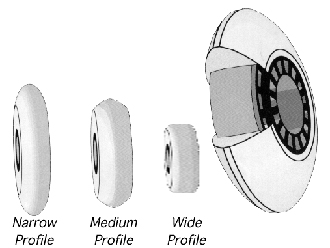300 different skate and scooter wheels
Skate wheel tutorial

300 different skate and scooter wheels
Skate wheel tutorial

Skate wheels are measured by 1) height and 2) hardness. Consider the numbers 76mm x 82a. This means the wheel is 76mm tall and 82a hard. 76mm is plain enough. A millimeter equals .03937 of an inch, so that 76mm means the wheel stands 2.992 inches tall. While we're at it, all our inline skate and most of our scooter wheels are 24mm wide. A very few kids' inline skate wheels are 18mm wide, but we do not carry them. Finally, skateboard and longboard wheels are normally much wider than 24mm, but we normally note that in our descriptions.
Hardness is measured by durometer ("a"), so that an 80a is harder than a 74a. This system is abused, however, by manufacturers who claim, for example, that some of their wheels are are as hard as diamonds ("100a"), the highest end of the durometer scale. Also, it is difficult for manufacturers to actually achieve the durometer they are aiming for, so that it is common for a wheel marked 82a to actually measure 78a. Absent a relatively sophisticated measuring instrument, however, the durometer rating system is the best we have going, and we can always use our teeth and fingernails to compare the hardness of one wheel to another.
Profile (see diagram above) is another wheel consideration. Most recreational and hockey wheels have a recreational or medium profile. Most aggressive wheels have a wide or flat profile. A few hockey wheel carry a full-radius or round profile, and a few racing wheels have a narrow profile.
Rebound is measure of energy returned and usually the principal determinent of wheel quality and speed. Rebound is the principal determinent of how satisfactorily a wheel feels skating on it. Rebound is also the least documented of all wheel measures. We know of no manufacturer which readily admits the rebound of its wheels. Generally, American manufacturers offer higher rebound than European and especially Asian manufacturers, but with so many American-branded wheels made overseas, it is difficult to know anymore. Consequently, your easiest determinent is bounce. How high does the wheel bounce when dropped on a hard surface.
Finally, the core or hub of a wheel depends on the intended use of the wheel. Aggressive wheels destined for a lot of abuse have little or no core. They are generally all urethane, all wheel. Hockey wheels often have heavy duty cores to take the repetitive stress of twisting and turning. The result of these core designs is a heavier, more durable wheel. Racing wheels have tall, light, spidery hubs intended to reduce the overall weight of the wheel.
Which skate wheel for you? Hockey wheels often function fine as recreational wheels, but do not expect a recreational wheel to function well as a hockey wheel because the core is not designed to take the stress of a hockey game. For the same reason, do not attempt to use a recreational wheel as an aggressive wheel.
Soft wheels grip. Hard wheels slip. Soft wheels wear rapidly. Hard wheels wear slowly. Soft wheels are kinder to your knees. Hard wheels tend to be faster. Soft wheels are quieter. Skaters assume the best way to save money is to buy the hardest wheel they can find for the lowest price. Well, OK so long as you don't get into slippery surfaces that earn you a broken sturnum for the sake of a $4 savings.